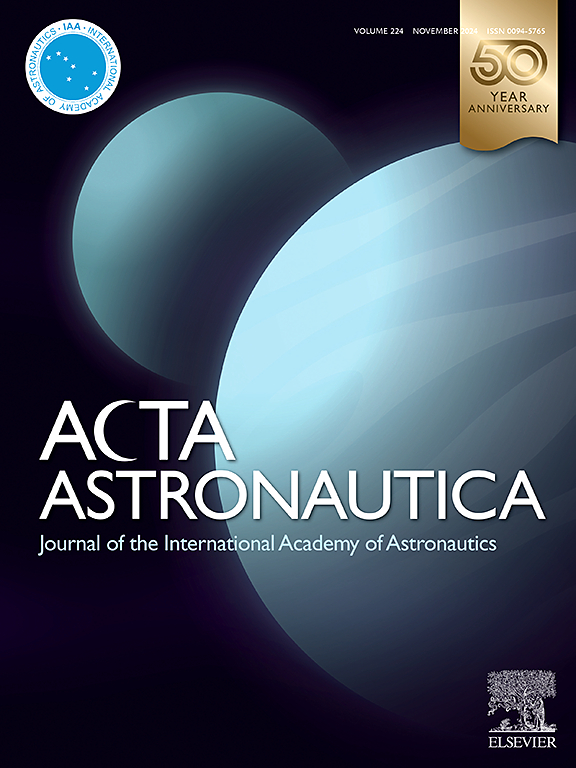基于cnn的主动碎片清除任务中相对状态和目标运动参数估计体系
IF 3.4
2区 物理与天体物理
Q1 ENGINEERING, AEROSPACE
引用次数: 0
摘要
本文提出了一种针对非合作非活动卫星的接近操作的原始相对导航架构,采用卷积神经网络进行基于单眼的姿态估计。其中,后一项任务采用间接方法,即使用YOLO家族的两个神经网络分别在图像中定位目标卫星,并识别一组与自然目标特征相对应的关键点。关键点的三维坐标与其在图像中的位置之间的对应关系用于解决结合解析和数值求解的透视n点问题。在此基础上,提出了一种估算目标角速度及其协方差的方法。将姿态和目标角速度信息作为测量值集成到乘式扩展卡尔曼滤波器在不同频率下的校正步骤中;这种方法可以提高旋转状态估计的精度,特别是在处理翻滚卫星时。使用开源软件Blender生成了一个由20000张ENVISAT卫星合成图像组成的新数据集,该数据集考虑了目标相对位置、姿态、太阳光照和背景中地球的存在等可变条件,以训练网络。生成了几个测试数据集来验证所提出的方法,模拟具有旋转和翻滚目标的监测和接近场景。通过参数化研究,评估了关键点提取网络的大小和目标检测网络的抑制对相对导航精度的影响。结果表明,该方法在相对位置上的相对状态估计误差小于6%,在相对姿态上的相对状态估计精度为度级,在相对速度和目标角速度估计误差分别小于6 cm/s和0.1°/s;即使在角速率高达1°/s的翻滚卫星下,目标角速度估计的精度仍保持不变。本文章由计算机程序翻译,如有差异,请以英文原文为准。
A CNN-based architecture for relative state and target motion parameters estimation in active debris removal missions
This paper presents an original relative navigation architecture for proximity operations towards an uncooperative inactive satellite, employing convolutional neural networks for monocular-based pose estimation. In particular, this latter task is performed following an indirect approach, in which two neural networks of the YOLO family are employed to respectively locate the target satellite in the image and identify a set of key-points corresponding to natural target features. The resulting correspondences between the 3D coordinates of the key-points and their positions in the image are used to solve a Perspective-n-Point problem combining analytical and numerical solvers. In addition, an original strategy is introduced to get estimates of the target angular velocity and of its covariance. Such pose and target angular velocity information are integrated as measurements in the correction step of a Multiplicative Extended Kalman Filter at different frequencies; this approach allows improving rotational state estimation accuracy, especially when dealing with tumbling satellites. A new dataset of 20000 synthetic images of the ENVISAT satellite is generated using the open-source software Blender, accounting for variable conditions in terms of target relative position, attitude, Sun illumination and presence of the Earth in the background, to train the networks. Several testing datasets are generated to validate the proposed methods, simulating monitoring and approach scenarios with spinning and tumbling targets. A parametrical study is also conducted to assess the effect of the size of the key-points’ extraction network and of the suppression of the target detection network on relative navigation accuracy. Results show the capability to estimate the relative state with errors of less than 6 % of the range on relative position and with degree-level accuracy on relative attitude, while relative velocity and target angular velocity are estimated with errors of less than 6 cm/s and 0.1°/s, respectively; the accuracy of target angular velocity estimation is preserved even with tumbling satellites having angular rates up to 1°/s.
求助全文
通过发布文献求助,成功后即可免费获取论文全文。
去求助
来源期刊

Acta Astronautica
工程技术-工程:宇航
CiteScore
7.20
自引率
22.90%
发文量
599
审稿时长
53 days
期刊介绍:
Acta Astronautica is sponsored by the International Academy of Astronautics. Content is based on original contributions in all fields of basic, engineering, life and social space sciences and of space technology related to:
The peaceful scientific exploration of space,
Its exploitation for human welfare and progress,
Conception, design, development and operation of space-borne and Earth-based systems,
In addition to regular issues, the journal publishes selected proceedings of the annual International Astronautical Congress (IAC), transactions of the IAA and special issues on topics of current interest, such as microgravity, space station technology, geostationary orbits, and space economics. Other subject areas include satellite technology, space transportation and communications, space energy, power and propulsion, astrodynamics, extraterrestrial intelligence and Earth observations.
 求助内容:
求助内容: 应助结果提醒方式:
应助结果提醒方式:


